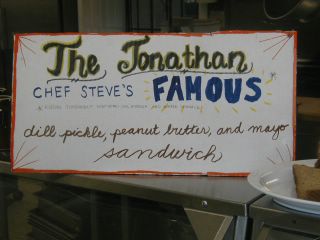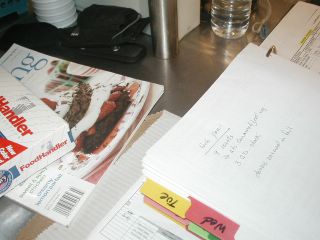Purchase More Ready-to-Cook Food
On Monday night of the second year of camp, I sliced my right thumb while forcing 40 pounds of red potatoes though the julienne blades of a mandoline. My hand slipped as I jammed the 10th potato through. After cleaning the mess, I stood in front of the cutting board for the next hour thinking that I could've purchased a ready-to-cook diced potato and saved injury for another occasion.

We sometimes offer alternative sandwiches just for fun. One such sandwich is The Jonathan, a peanut butter, mayonnaise and dill pickle sandwich that I've enjoyed since childhood. The sandwich is named after Jonathan, an admissions councilor for Florida College, who ate them by the dozen in the weeks after the 2003 session.
Last year, I started purchasing a few more ready-to-cook products. Any number of products qualify: most baking mixes, bottled barbecue sauce, bottled syrup, par-cooked diced potatoes, frozen corn-on-the-cob, ready-to-bake pizza shells, etc. The key is to balance scratch cooking with the labor- and time-saving features of "convenience" foods. This reduces the workload of the kitchen crew and gives us time to pursue other things, like Bible class.
I use the "Get more bang for your buck" theory of food purchasing. A complete heat-and-serve menu would be cost prohibitive. More than half of our entrees are scratch produced. Most of the scratch-produced meals are relatively easy to cook. The taco meat with all the fixin's (Tuesday lunch), pork roast with stuffing and mashed potatoes (Thursday dinner) and the chicken quesadillas with beans and Mexican rice (Friday lunch) are prime examples.
A few meals are earmarked for special handling: I bake scratch made pizza crusts (Monday dinner) and the homemade cinnamon rolls (Wednesday breakfast) because I enjoy baking these items. Another chef may elect to purchase proof-and-bake products. Skill level of the cooks and the time to produce the pizza or pastry from scratch will be the determining factors.
Keep the Menu Simple
It's true that campers enjoy good food. You should see the number of “I hate camp food” messages on the counselor's message board at ACACamps.org. Those messages sometimes give you the impression that we're suffering as a nation from an epidemic retched camp cooking.
One corner of my "desk"--a stainless steel prep table in the center of the kitchen. I organize all of the recipes by day and meal in a three-ring binder.
Kids enjoy simple fare, especially if the food reminds them of home cooking. The menu doesn't have to be complex in order to be good. You just need to purchase quality vittles and "hire" volunteers who're dedicated to serving in the kitchen.
Each meal served at Northern California FC Camp follows the basic institutional menu pattern:
- Salad (tossed green plus a few extras)
- Soup (lunch only)
- Entree (usually meat-based; we don't have any vegetarians yet)
- Starch or bread
- Vegetable (dinner only)
- Dessert
- Beverages


No comments:
Post a Comment